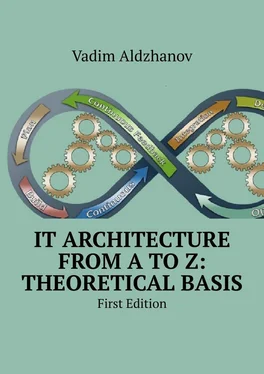An equilateral triangle with equal sides indicates the planned values for cost, time, and scope. The picture changes depending on the deviation from the baseline values.
Project results are measured at regular intervals.
Time is measured by the time spent on the project.
Actual expenses measure costs.
Scope is measured as a percentage of the planned and completed work.
Measured values on the reporting date are applied to the axes and generate a new triangle, which is different from the original equilateral triangle. Project Management Triangle is applicable to demonstrate intermediate and general project results.
Other Methods and Techniques
Assumptions Analysis is a method used for the accuracy analysis of the assumptions and the identification of project risks, caused by inaccuracy, incompleteness or contradictory assumptions. Any project and any specific project risk is initiated and executed based on a number of hypotheses, scenarios and assumptions. Assumptions analysis explores the validity of the assumptions applied to the project. This analysis allows identifying project risks arising from inaccuracies, instabilities, inconsistencies or incompleteness of assumptions.
Expected Monetary Value (EMV) Analysis is a statistical method that calculates the average result with future scenarios that might occur. Typically, this method is used as a part of decision tree analysis.
Variance Analysis is an analysis of total variance of content variables, cost, and schedule as variance of individual elements linked to certain factors and affecting the variables of content, cost, and schedule.
Schedule Network Analysis or Network Analysis is a method for determining early and late starts and early and late finishes for incomplete project operations. See also Critical Path Method, Critical Chain Method, analysis of available scenarios and resource leveling.
Trend Analysis is an analytical method using mathematical models to predict future results based on historical data. This method allows determining the variance from the base plan by cost, time or content using data from previous reporting periods and predicting the variance of this parameter at a certain point in the future, if no changes are made to the project.
Reserve Analysis combines analysis methods to identify the essential characteristics and interrelationships of the elements in a project management plan for establishing a reserve for the duration of the schedule, budget, estimated cost or project funds.
Sensitivity Analysis is a method of quantitative risk analysis and modeling used to determine the risks with the greatest likelihood to affect the project. The analysis establishes the impact of uncertainty of each project element within the studied project objective, if the remaining indefinite elements have basic values. Usually these results are presented as a tornado diagram.
Fast tracking is a special method for compressing a project schedule that changes the network logic by overlaying phases that would have been performed sequentially, for example, the design and construction phases, or parallel performance of planned operations.
Resources Leveling is a method of optimizing the load of project resources by arranging the optimal project performance, taking into account task priority, deadlines for implementation and limited resources.
Decomposition is a method of splitting the project content and project delivery results into smaller and easily manageable elements as long as the performance related activities on the project content and ensuring the delivery results are not sufficiently specified to perform, track and monitor these activities.
Precedence Diagramming Method (PDM) is a method for creating network diagrams in which planned operations are represented by rectangles (or nodes). Scheduled operations are graphically related to one or more logical relationships that show the sequence of operations.
Network Diagram Method is a common group of visual graph display. Unlike Gantt chart, the network diagrams graphically display the dependencies between the operations, as well as the duration of each of them and resources assigned. It is then determined which tasks are critical and which ones are not. There are two types of network diagrams, i.e. Critical Path Method (CPM) and Meta Potential Method (MPM).
Critical Path Method (CPM) is a step-by-step (network diagram) method used in the implementation of interdependent tasks. The activities are listed, their decomposition structure, time scale, dependencies, reference points and results are determined. Critical and non-critical activities are distinguished by calculating the greatest (on the critical path) and the smallest (floating) execution time of various tasks. The critical path method is often used in construction and characterized by a clearly defined project path; this path is formed by the longest project activities. The critical path determines the duration of the entire project. By defining and identifying the most important tasks, one can estimate completion dates, dependencies, key milestones, and final results. Any delays in activities within a critical path lead to increasing duration of further activities. If the project duration reduced, the terms of critical activities should also be reduced. Using the critical path method allows you to compare planned and actual indicators (how the situation should develop and what is actually happening) every day. The method consists of four planning stages:
• Goals and limitations (considering the project in several aspects – duration, quality, etc.);
• Duration of activity;
• Network schedule;
• Gantt chart.
Critical Chain Method (CCM) differs from the critical path method by focusing on the use of project resources, rather than project activities. Potential problems with resources, are resolved via buffers to ensure the timely implementation of projects in compliance with all required safety measures. Critical chain method helps avoid delays in the project, determining the critical path of activities, as well as resource reserves (lead-time) for these activities. Since the charts consider the availability of resources, the project may take longer, but the likelihood of failure to meet key events may be reduced. The basis of critical chain method is the formation of the main critical activities of the project and the retention of the terms of activity, as well as the project’s final completion date. Critical activities of the project are logically linked, taking into account resource and administrative constraints. If project resources are not limited, the estimated indicators will be similar to PERT. If the project still has limited resources, it is necessary to:
• determine near-critical work in the schedule, such work very often runs parallel to the main “red” chain, but being reduced, they may easily become critical if they are ignored.
• define a critical project chain using resource links.
Monte Carlo Analysis is a method that recalculates (or iterates) of a project cost or project duration using input values randomly taken from possible values of cost or duration in order to obtain the distribution of value likelihood of the total project cost or project completion dates.
Value Engineering (VE) is a creative approach to optimizing cost at the stages of the project life cycle, reducing time costs, increasing profits, improving quality, expanding the market, solving problems and / or improving the efficiency of resource use.
Читать дальше












